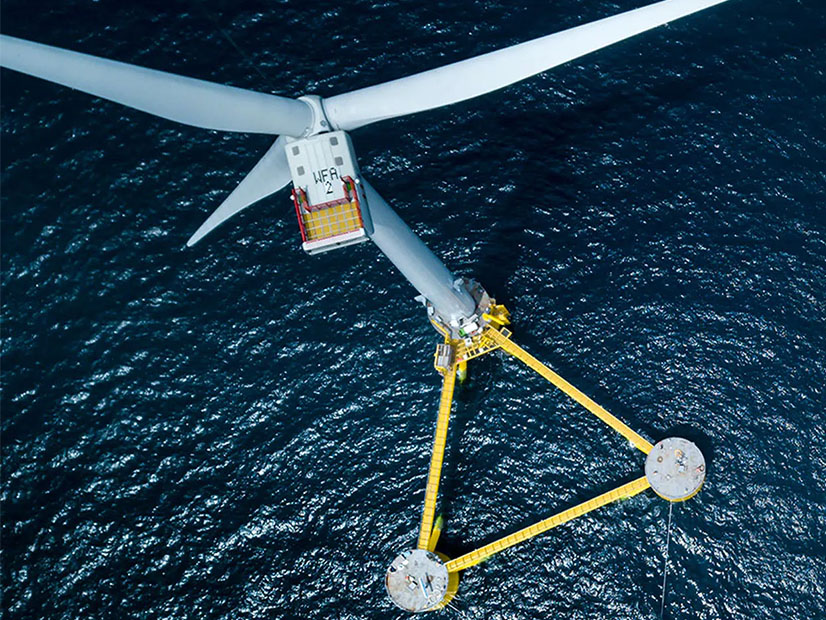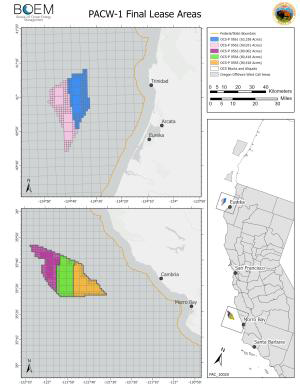
The West Coast’s first offshore wind auction will take place Dec. 6 for five leases off the Northern and Central California coasts that together could generate 4.5 GW of electricity, the U.S. Bureau of Ocean Energy Management said Tuesday.
The 373,268 acres, or 583 square miles, of deep-sea lease areas will also be the first to require floating wind turbines in U.S. coastal waters.
The sale is crucial to achieving the Biden administration’s recently stated goal of deploying 15 GW of floating offshore wind by 2035, the Interior Department said.
 Five areas off the coast of Northern and Central California will be leased. | BOEM
Five areas off the coast of Northern and Central California will be leased. | BOEM“Today, we are taking another step toward unlocking the immense offshore wind energy potential off our nation’s West Coast to help combat the effects of climate change while lowering costs for American families and creating good-paying union jobs,” Interior Secretary Deb Haaland said in the release.
The final sale notice followed BOEM’s issuance of a proposed sale notice in May for two leases in the Humboldt Wind Energy Area off the coast of Northern California and three leases in the Morro Bay Wind Energy Area off Central California.
The areas hold 5 to 7 GW of total capacity, the National Renewable Energy Laboratory said in June, amid discussions of increasing the state’s offshore wind goals.
The California Energy Commission in August boosted the state’s long-term OSW goal to 25 GW by 2045, potentially doubling anticipated long-term capacity, in response to urging by stakeholders and Gov. Gavin Newsom.
The governor praised BOEM’s action Tuesday, calling it “a historic step today toward achieving [California’s] goal of 90% clean energy by 2035 and moving the state away from fossil fuels.” The state has a 100% clean-energy mandate by 2045; the 2035 goal is an interim target.
“California could not have better partners in our march toward a clean energy future than the Biden-Harris administration,” Newsom said in a statement. “Together, we’re fighting for energy independence and a future free of fossil fuels and full of clean energy sources like offshore wind.”
The bureau’s decision to set a date “sends a powerful signal that the federal agency is moving forward with speed and scale to support California in reaching its ambitious planning goals to deploy up to 5 GW of floating offshore wind power by 2030 and a nation-leading 25 GW by 2045,” Adam Stern, executive director of trade group Offshore Wind California, said in a statement.
BOEM Director Amanda Lefton first announced the news of the decision to issue a final sale notice (FSN) on Tuesday morning during her keynote remarks to the Offshore WINDPOWER conference in Providence, R.I., hosted by the American Clean Power Association.
The FSN was also published Tuesday on BOEM’s California website. In it, the bureau identified 43 eligible bidders it deemed “legally, technically and financially qualified to hold a commercial wind lease offshore California.” They include companies such as Avangrid Renewables, BP US Offshore Wind Energy, Equinor Wind US, Orsted North America and Shell New Energies. To participate, bidders must deposit $5,000,000 by Nov. 12.
The FSN lays out the details of the upcoming auction, lease areas and lease provisions and conditions. One new provision is that “BOEM will offer bidding credits for bidders who enter into community benefit agreements or invest in workforce training or supply chain development; require winning bidders to make efforts to enter into project labor agreements; and require engagement with tribes, underserved communities, ocean users and agencies.”
The auction will be one of many developments needed to get OSW up and running in California in coming years.
Port infrastructure, for instance, remains a major obstacle. The Port of Humboldt Bay is slated to serve the 1.6-GW Humboldt WEA but requires wholesale redevelopment. The CEC gave the historic timber port’s operator $10.5 million in March to begin upgrading its facilities.
The Morro Bay WEA could be served by several ports, including Long Beach near Los Angeles or Hueneme in Ventura County.
The wind ports must be capable of handling the massive platforms expected off California, potentially larger than any yet afloat at 900 feet tall and capable of generating 15 GW each.
Transmission is another issue. The Morro Bay WEA could tap into existing onshore infrastructure that serves the nearby Diablo Canyon nuclear power plant. Humboldt will require transmission to be built over mountainous terrain to reach the Pacific AC Intertie running down the center of the state or an undersea cable traveling more than 200 miles to the San Francisco Bay Area, developers have said.
“The West Coast market will singularly rival those on the global stage and could draw billions in U.S. supply chain investments,” Liz Burdock, CEO of the Business Network for Offshore Wind, said in a statement Tuesday. “However, the U.S. must move with urgency to capture this rare economic opportunity by freeing up critical support for port and transmission investments, and do the hard work to identify and build an American supply chain that will anchor the U.S. as a global industry leader.”
BOEM has plans to open two areas for OSW development totaling almost 1.2 million acres off of Oregon. The Coos Bay Call Area and the Brookings Call Area are 12 nautical miles from shore at their closest points. (See BOEM Moves on OSW Plans for Oregon, Central Atlantic.)
